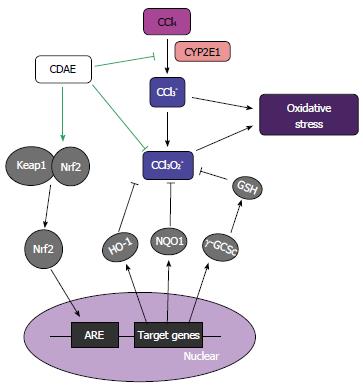Copyright
©The Author(s) 2017.
World J Gastroenterol. Apr 28, 2017; 23(16): 2912-2927
Published online Apr 28, 2017. doi: 10.3748/wjg.v23.i16.2912
Published online Apr 28, 2017. doi: 10.3748/wjg.v23.i16.2912
Figure 8 Summary of the mechanism underlying Cortex Dictamni aqueous extract inhibition of CCl4-induced live damage.
CCl4 accumulates in hepatic parenchymal cells and is metabolized by cytochrome P450 2E1 (CYP2E1) to produce free radicals, including CCl3- and CCl3O2-, which induce oxidative stress and oxidative injury. CDAE suppresses CCl4 metabolism by reducing CYP2E1 expression and subsequently inhibiting the production of free radicals. In addition, CDAE activates nuclear factor E2-related factor (Nrf2)-mediated antioxidants, including heme oxygenase-1 (HO-1), NAD(P)H quinine oxidoreductase 1 (NQO1), and γ-glutamylcysteine synthetase catalytic subunit (γ-GCSc), which contribute to the scavenging of free radicals. CDAE: Cortex Dictamni aqueous extract; GSH: Glutathione.
- Citation: Li L, Zhou YF, Li YL, Wang LL, Arai H, Xu Y. In vitro and in vivo antioxidative and hepatoprotective activity of aqueous extract of Cortex Dictamni. World J Gastroenterol 2017; 23(16): 2912-2927
- URL: https://www.wjgnet.com/1007-9327/full/v23/i16/2912.htm
- DOI: https://dx.doi.org/10.3748/wjg.v23.i16.2912









